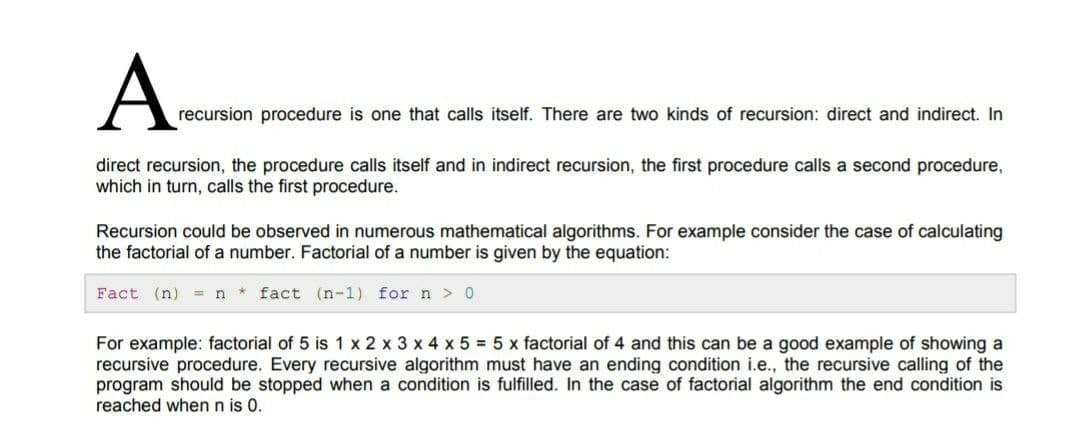A recursion procedure is one that calls itself. There are two kinds of recursion: direct and indirect. In direct recursion, the procedure calls itself and in indirect recursion, the first procedure calls a second procedure, which in turn, calls the first procedure. Recursion could be observed in numerous mathematical algorithms. For example consider the case of calculating the factorial of a number. Factorial of a number is given by the equation: Fact (n) = n * fact (n-1) for n > 0 For example: factorial of 5 is 1 x 2 x 3 x 4 x 5 = 5 x factorial of 4 and this can be a good example of showing a recursive procedure. Every recursive algorithm must have an ending condition i.e., the recursive calling of the program should be stopped when a condition is fulfilled. In the case of factorial algorithm the end condition is reached when n is 0.
A recursion procedure is one that calls itself. There are two kinds of recursion: direct and indirect. In direct recursion, the procedure calls itself and in indirect recursion, the first procedure calls a second procedure, which in turn, calls the first procedure. Recursion could be observed in numerous mathematical algorithms. For example consider the case of calculating the factorial of a number. Factorial of a number is given by the equation: Fact (n) = n * fact (n-1) for n > 0 For example: factorial of 5 is 1 x 2 x 3 x 4 x 5 = 5 x factorial of 4 and this can be a good example of showing a recursive procedure. Every recursive algorithm must have an ending condition i.e., the recursive calling of the program should be stopped when a condition is fulfilled. In the case of factorial algorithm the end condition is reached when n is 0.
Computer Networking: A Top-Down Approach (7th Edition)
7th Edition
ISBN:9780133594140
Author:James Kurose, Keith Ross
Publisher:James Kurose, Keith Ross
Chapter1: Computer Networks And The Internet
Section: Chapter Questions
Problem R1RQ: What is the difference between a host and an end system? List several different types of end...
Related questions
Question
algoritm if possible or code

Transcribed Image Text:A-
recursion procedure is one that calls itself. There are two kinds of recursion: direct and indirect. In
direct recursion, the procedure calls itself and in indirect recursion, the first procedure calls a second procedure,
which in turn, calls the first procedure.
Recursion could be observed in numerous mathematical algorithms. For example consider the case of calculating
the factorial of a number. Factorial of a number is given by the equation:
Fact (n) = n * fact (n-1) for n > 0
For example: factorial of 5 is 1 x 2 x 3 x 4 x 5 = 5 x factorial of 4 and this can be a good example of showing a
recursive procedure. Every recursive algorithm must have an ending condition i.e., the recursive calling of the
program should be stopped when a condition is fulfilled. In the case of factorial algorithm the end condition is
reached when n is 0.
Expert Solution
This question has been solved!
Explore an expertly crafted, step-by-step solution for a thorough understanding of key concepts.
Step by step
Solved in 2 steps

Recommended textbooks for you

Computer Networking: A Top-Down Approach (7th Edi…
Computer Engineering
ISBN:
9780133594140
Author:
James Kurose, Keith Ross
Publisher:
PEARSON

Computer Organization and Design MIPS Edition, Fi…
Computer Engineering
ISBN:
9780124077263
Author:
David A. Patterson, John L. Hennessy
Publisher:
Elsevier Science

Network+ Guide to Networks (MindTap Course List)
Computer Engineering
ISBN:
9781337569330
Author:
Jill West, Tamara Dean, Jean Andrews
Publisher:
Cengage Learning

Computer Networking: A Top-Down Approach (7th Edi…
Computer Engineering
ISBN:
9780133594140
Author:
James Kurose, Keith Ross
Publisher:
PEARSON

Computer Organization and Design MIPS Edition, Fi…
Computer Engineering
ISBN:
9780124077263
Author:
David A. Patterson, John L. Hennessy
Publisher:
Elsevier Science

Network+ Guide to Networks (MindTap Course List)
Computer Engineering
ISBN:
9781337569330
Author:
Jill West, Tamara Dean, Jean Andrews
Publisher:
Cengage Learning

Concepts of Database Management
Computer Engineering
ISBN:
9781337093422
Author:
Joy L. Starks, Philip J. Pratt, Mary Z. Last
Publisher:
Cengage Learning

Prelude to Programming
Computer Engineering
ISBN:
9780133750423
Author:
VENIT, Stewart
Publisher:
Pearson Education

Sc Business Data Communications and Networking, T…
Computer Engineering
ISBN:
9781119368830
Author:
FITZGERALD
Publisher:
WILEY